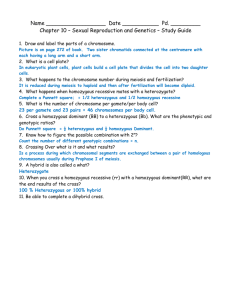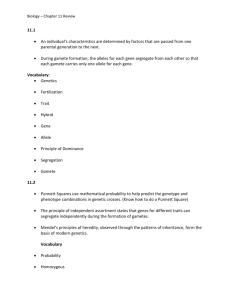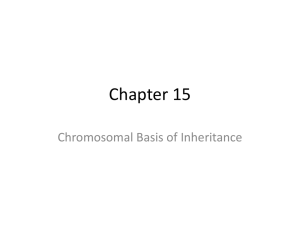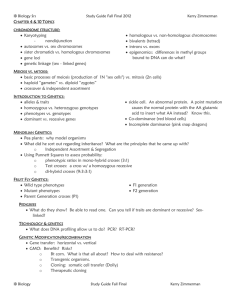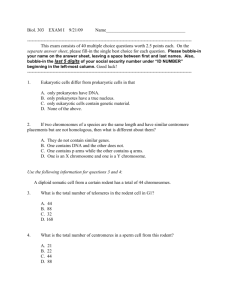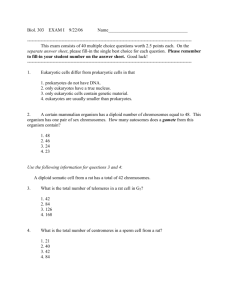Standards and Objectives
advertisement
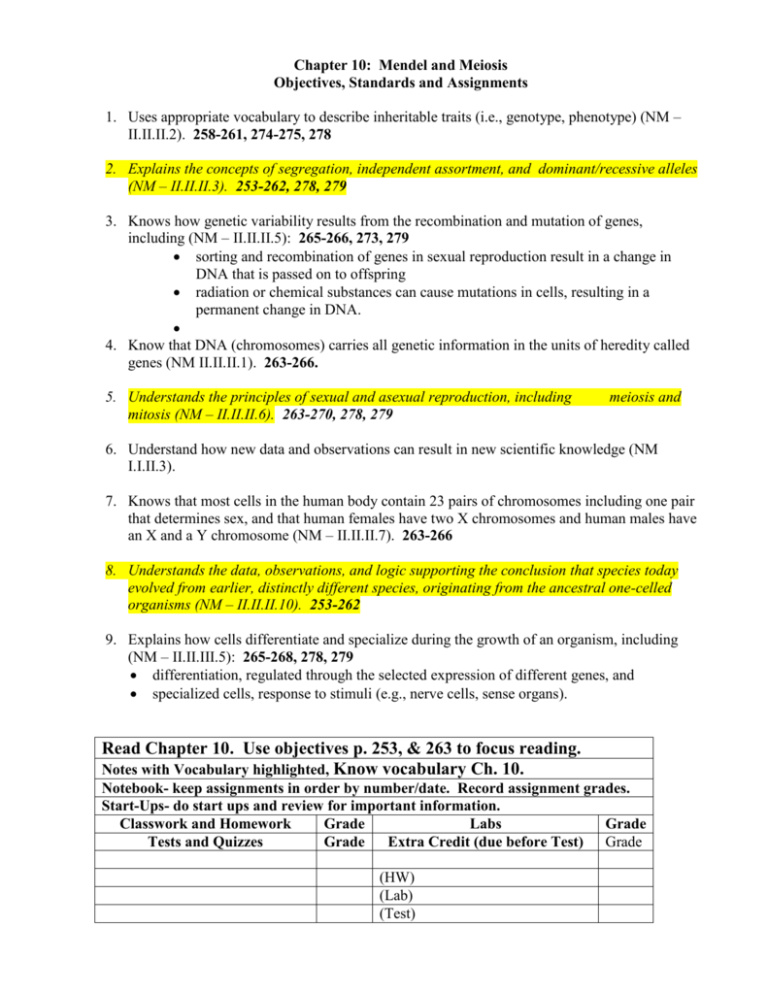
Chapter 10: Mendel and Meiosis Objectives, Standards and Assignments 1. Uses appropriate vocabulary to describe inheritable traits (i.e., genotype, phenotype) (NM – II.II.II.2). 258-261, 274-275, 278 2. Explains the concepts of segregation, independent assortment, and dominant/recessive alleles (NM – II.II.II.3). 253-262, 278, 279 3. Knows how genetic variability results from the recombination and mutation of genes, including (NM – II.II.II.5): 265-266, 273, 279 sorting and recombination of genes in sexual reproduction result in a change in DNA that is passed on to offspring radiation or chemical substances can cause mutations in cells, resulting in a permanent change in DNA. 4. Know that DNA (chromosomes) carries all genetic information in the units of heredity called genes (NM II.II.II.1). 263-266. 5. Understands the principles of sexual and asexual reproduction, including mitosis (NM – II.II.II.6). 263-270, 278, 279 meiosis and 6. Understand how new data and observations can result in new scientific knowledge (NM I.I.II.3). 7. Knows that most cells in the human body contain 23 pairs of chromosomes including one pair that determines sex, and that human females have two X chromosomes and human males have an X and a Y chromosome (NM – II.II.II.7). 263-266 8. Understands the data, observations, and logic supporting the conclusion that species today evolved from earlier, distinctly different species, originating from the ancestral one-celled organisms (NM – II.II.II.10). 253-262 9. Explains how cells differentiate and specialize during the growth of an organism, including (NM – II.II.III.5): 265-268, 278, 279 differentiation, regulated through the selected expression of different genes, and specialized cells, response to stimuli (e.g., nerve cells, sense organs). Read Chapter 10. Use objectives p. 253, & 263 to focus reading. Notes with Vocabulary highlighted, Know vocabulary Ch. 10. Notebook- keep assignments in order by number/date. Record assignment grades. Start-Ups- do start ups and review for important information. Classwork and Homework Grade Labs Grade Tests and Quizzes Grade Extra Credit (due before Test) Grade (HW) (Lab) (Test) Chapter 10: Mendel and Meiosis Standards and Objectives 1. Use appropriate vocabulary to describe inheritable traits (i.e., genotype, phenotype) (NM – II.II.II.2). 258-261, 274-275, 278 a. define and know the following terms allele fertilization zygote gamete genetics genotype heredity heterozygous homozygous hybrid phenotype pollination 2. Explain the concepts of segregation, independent assortment, and dominant/recessive alleles (NM – II.II.II.3). 253-262, 278, 279 a. Describe the Law of Segregation and the Law of Independent Assortment. b. Distinguish between, and give examples of. dominant and recessive alleles. 3. Understand how new data and observations can result in new scientific knowledge (NM I.I.II.3). a. Briefly outline Mendel’s methods, including the terms: parent generation (P1), first generation (F1) and second generation (F2). b. Be able to predict the results of a monohybrid cross and a dihybrid cross (review Using Punnett Squares to Predict the Outcomes of Crosses). 4. Know that DNA (chromosomes) carries all genetic information in the units of heredity called genes (NM II.II.II.1). 263-266. a. Describe the structure of a chromosome & define the term homologous chromosome. b. Define diploid and haploid, and give examples of each kind of cell. 5. Understand the principles of sexual and asexual reproduction, including meiosis and mitosis (NM – II.II.II.6). 263-270, 278, 279 a. Briefly describe the process of meiosis. b. Compare the end products of mitosis with those of meiosis (number of chromosomes). c. Summarize the main characteristics of spermatogenesis and oogenesis. 6. Know how genetic variability results from the recombination and mutation of genes, including (NM – II.II.II.5): 265-266, 273, 279. sorting and recombination of genes in sexual reproduction result in a change in DNA that is passed on to offspring 7. Know that most cells in the human body contain 23 pairs of chromosomes including one pair that determines sex, and that human females have two X chromosomes and human males have an X and a Y chromosome (NM – II.II.II.7). 263-266 8. Understands the data, observations, and logic supporting the conclusion that species today evolved from earlier, distinctly different species, originating from the ancestral one-celled organisms (NM – II.II.II.10). 253-262 9. Explains how cells differentiate and specialize during the growth of an organism, including (NM – II.II.III.5): 265-268, 278, 279 differentiation, regulated through the selected expression of different genes, and specialized cells, response to stimuli (e.g., nerve cells, sense organs).





